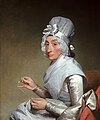Gilbert Stuart
Gilbert Charles Stuart (born December 3, 1755 as Stewart in North Kingstown , Colony of Rhode Island and Providence Plantations , † July 9, 1828 in Boston , Massachusetts ) was an American painter . He is considered to be the most important early American portrait painter .
Life
Growing up in Newport , Rhode Island, Stuart first took lessons from the Scottish painter Cosmo Alexander (1724–1772). With him he went to Scotland in 1771 to finish his education. His teacher died in Edinburgh the following year . After Stuart tried unsuccessfully to make a living from painting, he returned to Newport in 1773.
Due to the American Revolutionary War and the associated social upheaval, however, Stuart's opportunities to work as a portrait painter in America soon dwindled, and he followed the example of John Singleton Copley and went to England in 1775. In London he spent the next six years studying with the painter and then director of the Royal Academy of Arts , Benjamin West . Stuart was able to exhibit his paintings for the first time in the Royal Academy as early as 1777. Success came in 1782 with the portrait of William Grant The Skater . From then on, Stuart achieved prices for his pictures that were only surpassed by painters such as Joshua Reynolds and Thomas Gainsborough . Despite many assignments, Stuart had constant money problems and in 1787 had to flee to Ireland from his debtors. In Dublin he continued his painting activity, but accumulated debt over time, whereupon he returned to America in 1793.
After initially settling in New York , Stuart set up a studio in Philadelphia in 1795 . Here his fame as a portraitist for important Americans of his time was founded. He painted a series of pictures of George Washington , which he then copied in series to meet the growing demand. This ensured his financial livelihood for years. The best-known image in this series is the so-called Athenaeum Head , which can be seen today on the 1 dollar note; also known is the so-called Lansdowne Portrait . A life-size portrait of Washington hangs in the East Office of the White House today . When British forces burned Washington, DC in 1812 , it was Dolley Madison who saved the picture.
Gilbert Stuart opened a studio in Washington in 1803 and moved to Boston in 1805 . By the end of his career, Stuart painted over a thousand personalities from the still young American history, including the first six American presidents. He was praised for his lifelike and natural portraits and appreciated for his sociability. John Adams commented, “It is usually torture to be painted. One has to remain in a compulsive and unnatural position and patience is tested. But for Stuart I could be a model from January 1st to the end of December: I can do whatever I want and have a good conversation. ” Stuart worked without preliminary drawings and painted directly on the canvas.
In 1824, Stuart had a stroke . Although he was partially paralyzed and also suffered from gout , he continued to work as a painter. In 1827 he was one of the first Honorary NA members to be elected by the newly established National Academy of Design . He died in Boston at the age of 72 and was buried in the Old South Burial Ground.
George Washington - Athenaeum Head
George Washington - Lansdowne Portrait
literature
- George C. Mason: The life and works of Gilbert Stuart . Charles Scribner's Sons, New York 1879 ( digitized ).
- Charles Allen Munn: Three types of Washington portraits; John Trumbull, Charles Wilson Peale, Gilbert Stuart . Privatly printed, The Gilliss Press, New York 1908 ( digitized version )
- Lawrence Park : Gilbert Stuart. An illustrated descriptive list of his work . 4 volumes, Rudge, New York 1926 ( digitized volume 1 , volume 2 , volume 3 , volume 4 ).
- William Thomas Whitley: Gilbert Stuart . Harvard University Press, Cambridge, Mass. 1932.
- William Sener Rusk : Stuart, Gilbert . In: Hans Vollmer (Hrsg.): General lexicon of fine artists from antiquity to the present . Founded by Ulrich Thieme and Felix Becker . tape 32 : Stephens – Theodotos . EA Seemann, Leipzig 1938, p. 224-225 .
- James Thomas Flexner: Gilbert Stuart. A Great Life In Brief . Alfred A. Knopf, New York 1955 ( digitized version ).
- Dorinda Evans: The genius of Gilbert Stuart . Princeton University Press, Princeton 1999, ISBN 0-691-05945-4 .
- Carrie Rebora Barratt, Ellen G. Miles: Gilbert Stuart . Exhibition catalog New York, Washington 2004/5, Yale University Press, New Haven 2004, ISBN 0-300-10495-2 .
- Dorinda Evans: Gilbert Stuart and the Impact of Manic Depression . Ashgate, Farnham 2012, ISBN 978-1-4094-4164-9 .
Web links
- Gilbert Stuart Birthplace & Museum
- Gilbert Stuart in the Metropolitan Museum of Art , with curriculum vitae
- Gilbert Stuart in the collection of the National Gallery of Art, Washington DC
- - Biography at gilbert-stuart.org
- Painting at gilbert-stuart.org
- Portraits by Gilbert Stuart in the National Portrait Gallery, London
Individual evidence
- ↑ Inside the White House .
- ↑ nationalacademy.org: Past Academicians "S" / Stuart, Gilbert Honorary 1827 ( Memento of the original from March 20, 2016 in the Internet Archive ) Info: The archive link was inserted automatically and has not yet been checked. Please check the original and archive link according to the instructions and then remove this notice. (accessed on July 17, 2015)
| personal data | |
|---|---|
| SURNAME | Stuart, Gilbert |
| ALTERNATIVE NAMES | Stuart, Gilbert Charles (full name); Stewart, Gilbert Charles (maiden name) |
| BRIEF DESCRIPTION | American painter |
| DATE OF BIRTH | December 3, 1755 |
| PLACE OF BIRTH | North Kingstown , Rhode Island |
| DATE OF DEATH | July 9, 1828 |
| Place of death | Boston |









